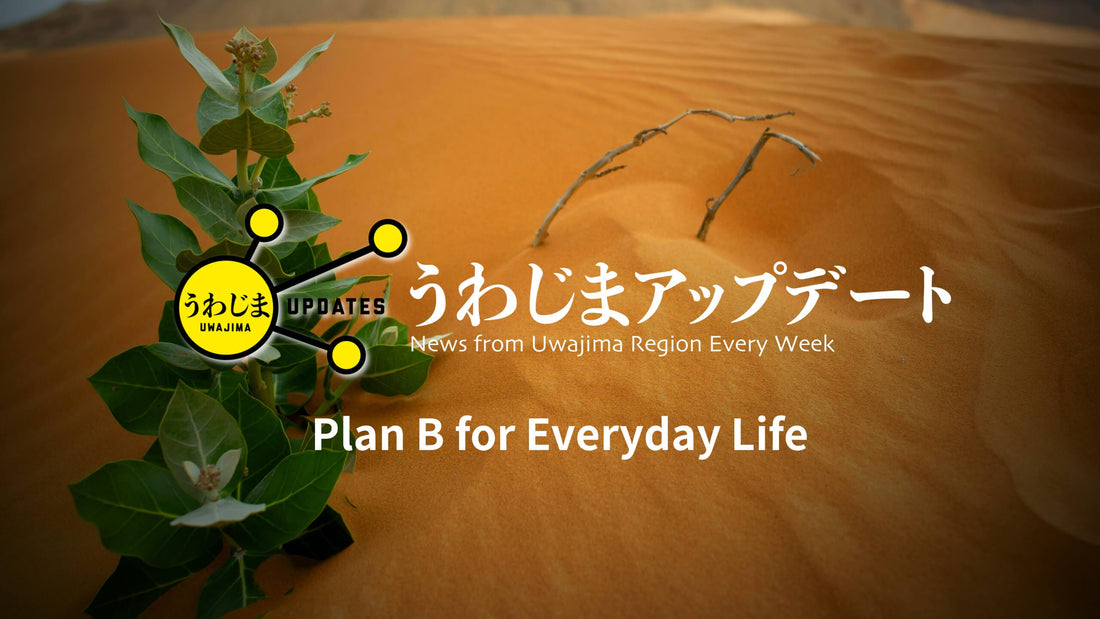
Uwajima Updates: Plan B in Everyday Life
Masaki SeikeShare
今週の「Uwajima Updates」のテーマは、“Plan B in Everyday Life”。
つまり、日常生活における「プランB」、バックアップの重要性について考えてみたいと思います。
情報共有会議 in えひめ のご案内
まずはイベントのお知らせです。
10月3日(金)午前10時から正午まで、宇和島市総合福祉センターで「情報共有会議 in えひめ」が開催されます(参加無料)。

この会議は「四国災害対策ローカルネットワーク構築事業」の一環で、災害に備える仕組みづくりを目的としています。
-
第1部 講演:「令和6年能登半島地震・奥能登豪雨 ― 地震と水害とこれから」
講師:槌谷雅也さん(輪島復興支援団体リガーレ) -
第2部 情報共有会議:
話題提供「災害対策基本法改正について」
講師:澤 邦之さん(内閣府防災担当)
さらにパネルディスカッションも予定されています。
お問い合わせ:
四国災害ボランティアネットワーク
TEL: 090-4971-8562
プランBとしての「二拠点生活」
1986年の帰国後に、県立農業大学校や県立高校などで英語講師の仕事があり、宇和島と松山を往復する二拠点生活が始まりました。やがて結婚、三人の子供を授かり、幸い自営業ということで時間の融通がきくことから、地元宇和島には週一で帰り両親の世話もしていました。やがて父が他界、母も施設での生活を始め、実家は私にとって落ち着いて仕事のできる第二の仕事場でした。そして、この日常は2018年の夏まで続きました。

2018年7月7日の深夜、西日本豪雨で実家は裏山の二ヶ所の土石流によって全壊。その前日に雨が激しくなったこともあり松山に帰っていたのですが、もし松山に戻っていなければ命を落としていたかもしれません。二つの拠点があったことで、災害から救われた――まさに「生活のバックアップ」が私を守ってくれたのです。

災害が多くなってきていることを肌で感じる今日この頃です。スマホにモバイルバッテリーを持つ安心感と同じように、暮らしにも「プランB」が必要です。
若い世代の挑戦と「贈る防災」
最近では防災を学ぶ機会も増え、資格を取る人も身近にいます。
実は、私の末娘も就職先の支援を受けて「防災士」の資格取得に向けて勉強中です。子供達が小さい頃に過ごした思い出の場所がなくなったことは、少なからず彼らの中の何かを変えたのかもしれません。
今回の放送回で、番組ディレクターとの会話で最近では、「贈る防災」という新しい発想もあることを学びました。防災グッズをプレゼントするという取り組みで、例えば「災害時に使える簡易トイレ用の砂」を贈るなど、普通は自分で買わないけれど、いざという時に役立つものを贈る。これも立派な「プランB」です。
日常にプランBを
「もしものとき」に備えた小さな工夫は、きっと誰かの命を守る力になります。
学びの場に参加すること、二つ目の拠点を考えること、防災グッズを贈ること――これらすべてが「日常のプランB」です。
ぜひ、皆さんも自分なりのプランBを探してみてください。
楽しみながら取り入れることで、防災はもっと身近になり、暮らしを支える強い味方になるはずです。
Uwajima Updates
Plan B in Everyday Life ― Rethinking Our Daily Backups
This week’s theme for Uwajima Updates is “Plan B in Everyday Life.”
In other words, we reflect on the importance of having a backup in our daily lives.
Disaster Information Sharing Conference in Ehime
On Friday, October 3rd, from 10 a.m. to noon, the “Disaster Information Sharing Conference in Ehime” will be held at the Uwajima City General Welfare Center. Admission is free.
This conference is part of the Shikoku Disaster Response Local Network Project, aiming to strengthen systems for disaster preparedness.
-
Session 1 – Lecture:
“The 2024 Noto Peninsula Earthquake and Heavy Rain: Earthquakes, Floods, and the Future”
Speaker: Masaya Tsuchiya (Ligare, Wajima Reconstruction Support Organization) -
Session 2 – Information Sharing:
Topic: “Revisions to the Disaster Countermeasures Basic Act”
Speaker: Kuniyuki Sawa (Cabinet Office, Disaster Prevention Division)
A panel discussion will also be held.
Contact:
Shikoku Disaster Volunteer Network
TEL: 090-4971-8562
Two-Base Lifestyle as a Plan B
After returning from the United States in 1986, I began working as an English instructor at the Prefectural Agricultural College and high schools. That was when my “two-base lifestyle,” traveling between Uwajima and Matsuyama, began.

Later, after marriage and having three children, I continued this routine—returning weekly to Uwajima to care for my parents while running my own business in Matsuyama. By 2018, my father had passed away and my mother was living in a care facility, so my family home became a quiet second workplace for me.



But on July 7, 2018, the Western Japan Heavy Rain Disaster triggered two landslides from the hillside behind the house, completely destroying it. Had I not returned to Matsuyama a day earlier, I might not be here today. Having two bases saved my life—truly, a “backup for living” that protected me.

With disasters occurring more frequently, I strongly feel that, just as we carry mobile batteries for our smartphones, we need a “Plan B” in our lives.
The Young Generation and “Gifting Preparedness”
Opportunities to learn about disaster preparedness are growing, and more people are pursuing certifications. In fact, my youngest daughter, with support from her workplace, is currently studying to become a certified Disaster Prevention Specialist. The loss of our family home—where she and her siblings spent their childhood—may have left a lasting impression that shapes her motivation today.

In preparing this program, I also learned from a conversation with our director about a new concept: “Gifting Preparedness.” This means giving disaster supplies as presents—for example, a bag of special sand for use in emergency toilets. It’s something most people would not buy for themselves, yet it could be life-saving in an emergency. This too is a valuable “Plan B.”
Finding Your Plan B in Daily Life
Small steps to prepare for the unexpected can become a lifeline for yourself or others. Attending learning opportunities, considering a second living base, or giving disaster supplies as gifts—these are all meaningful examples of “Plan B in Everyday Life.”

I encourage everyone to find their own Plan B. By incorporating preparedness in enjoyable ways, disaster prevention becomes more approachable, and a strong ally in protecting our lives and communities.
